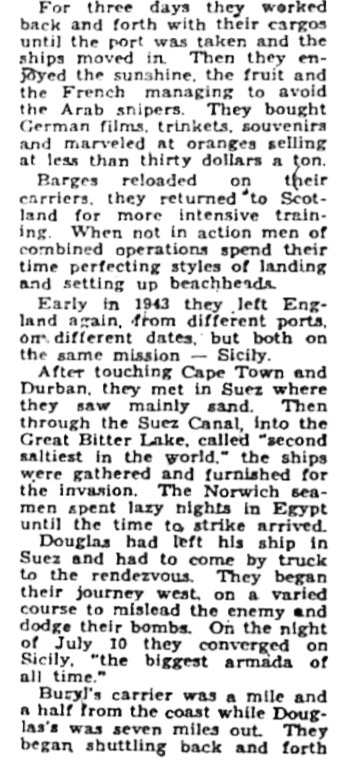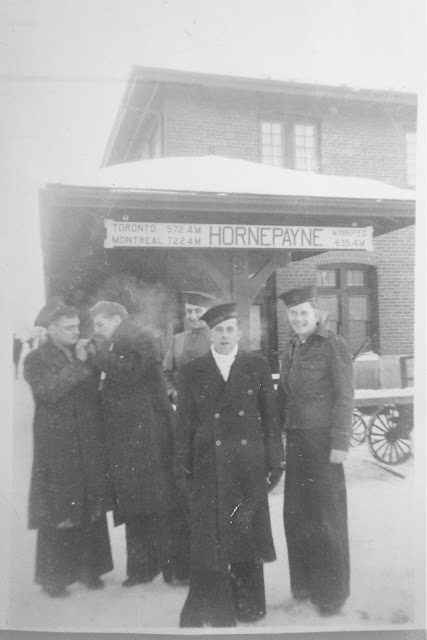Buryl and Doug Worked Together During the War
Photo Credit - London Central Library, microfilm of London
Free Press. Photo is cleaner but text is lighter
Photo Credit - Weldon Library, UWO, microfilm of The
Montreal Star. Photo is too dark but text is clearer
While at the University of Western Ontario recently, searching microfiche of 1943 issues of The Montreal Star for some hint of a story about my father's Canadian landing craft flotilla, at work in Reggio di Calabria during Sept. 1943 (Allied invasion of Italy), I also found reels upon reels of microfilm of my local paper, The London Free Press (LFP).
"Dad was interviewed by the LFP when he returned to Canada in '43, after two years overseas," I said to myself.
I had a copy the LFP interview but the text was faded, not crisp and clear like some articles in The Star. I found the LFP reel for Feb. 44 and on page 34 of the Feb. 5th issue I came upon the interview with Buryl McIntyre and Doug Harrison. I knew about the interview, I knew they'd worked together before, during and after the war, I had stories and photos about them both - but it sure felt good to see that a crisp, clear page of text continued to survive in my current hometown.
I say, "Well done, Buryl and Doug. Friends to the end."
The entire interview follows with two clearer photos, one from the Imperial War Museum, UK.:
The London Free Press included two brief captions with a pair of photos. Because Buryl's recollections re Dieppe are printed beside the first photograph, readers may believe the photo depicts action during the Dieppe Raid. It is actually from a training exercise taking place on Loch Fyne, near Inveraray, Scotland and on the shores of the Combined Operations No. 1 Training Camp (aka HMS Quebec). Buryl and Doug were barracked there in the spring and summer of 1942, as well as south of Irvine at Camp Auchengate, also for training aboard landing crafts) prior to the raid on Dieppe.
Photo Credit - Imperial War Museum. Hills opposite the camp on Loch Fyne
are in view above the smoke screen.
When I visited HMS Quebec the smoke screen was still there! 2014, GH
The second photo offered by the Free Press is an very good one
but I have been unable to locate an original w caption
Minus the blimps used to deter air raids. An LST (landing ship, (for) tanks)
empties its cargo near Rhino bridges (floating bridges), incl. a loaded lorry, front left (?).
An LCM (landing craft, mechanised; front, far right), a style very familiar to
Buryl and Doug carries the materiel of war to a peaceful shore (Sicily or Italy?)
Doug (left) and Buryl at Halifax, outside Wellington barracks, 1941
Don Linder (Kitchener), Doug Harrison, Joe Watson (Simcoe), Buryl McIntyre,
and Chuck Rose (Chippewa). Dressed up (outside Toronto train station) with some
place to go, i.e., Vancouver Island. Jan. 1944
Buryl (back), Chuck, Doug are ready to go west
to Canada's Combined Operations training camp
on Goose Spit, near Comox, BC
Don, Chuck, Buryl (back) Joe, Don Westbrook (Hamilton), stopping
in Hornepayne (N. Ontario) on their way to Comox. Jan. 1944
Photo Credit - Doug Harrison
Canadians in Combined Ops (and RCNVR) arrive in Comox at HMCS Givenchy III
Back - Don Linder, unknown, Buryl McIntyre, Art Warrick
Middle - Joe Spencer, Joe Watson
Front - Doug Harrison, Chuck Rose, Ed Chambers.
In the last photo, the sailors seem to look like they are wearing new uniforms or clothing (work clothes?) The camp is growing in size and usefulness and some will soon be instructing new recruits in seamanship skills. They also played a lot of baseball under good coaches and had access to many of Canada's finest landing crafts in which they would travel a few miles to Courtenay to dance at the Native Sons Hall, watch movies at Bickel's Movie Theatre or drink beer at the Riverside Hotel.
Buryl and Doug travelled back to Ontario in the late summer of 1945 (after being asked to volunteer for the Pacific theatre of war; they refused) and were discharged from RCNVR without penalties at HMCS Star in Hamilton, the site where they had enlisted more than four years earlier.
They returned to Norwich and worked together at the Norwich Co-op until Buryl's death at a relatively early age. Doug attempted to stay in his house on Washington Avenue even after the death of his wife Edith, nee Catton (my mother) in 2000. He eventually entered Parkwood Hospital, London, home to a few other WW2 vets, and lived there until his death in February, 2003.
Please link to Editor's Research: FO John Anthony Vasicek RCAF
Unattributed Photos GH




















No comments:
Post a Comment